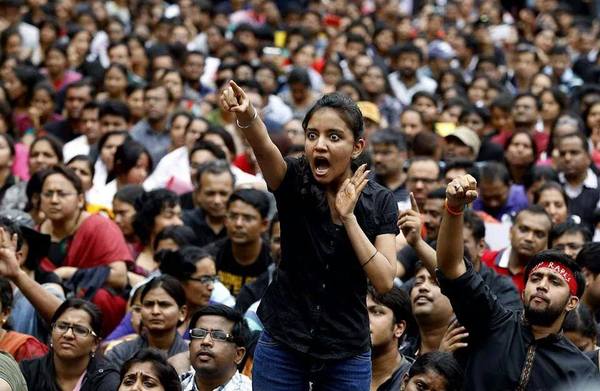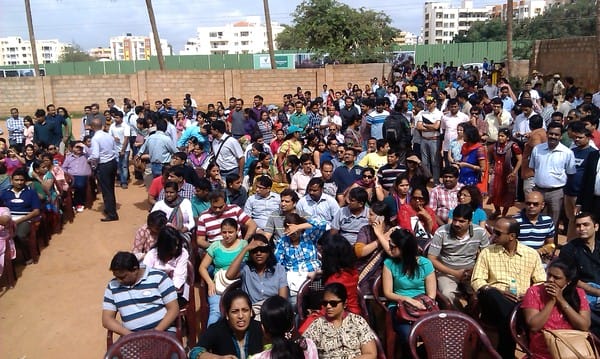
A demonstrator shouts slogans during a protest on July 19, 2014. Pic courtesy: Reuters
Some time ago, a couple of days after the rape of a school girl in a leading school, there was this very striking image, published on the front page of a leading newspaper; it was that of a visibly angry young woman who was part of a protest group appearing to shout at someone, maybe at someone in the school (we will probably never know).
That face and that anger which was so palpable, in essence captured the anger of a whole lot of people, be it parents, citizens from different strata of society and different individuals/groups. For the first few days and weeks, the mainstream media covered the protests on a fairly regular basis managing to get the seemingly ineffective government, police force and other government agencies to act, albeit sporadically and in a fairly disjointed manner.
More than a month after the incident, while there is still some media coverage, it fails to capture the sense of anger and outrage that still exists and will exist for a long time. Some of the issues which come to my mind that I should highlight are – what is a protest, why do certain issues get more traction than other issues, are we being insensitive by not actively taking part in or judging certain protests, can protests be more effective and force authorities to act more promptly.
Why are protests staged in particular places?
To me, a protest is an action to highlight certain failings in the system (whatever that system might be). It is an attempt by either an individual or a group of aggrieved people to highlight their cause/plight usually to some form of public authority, and the general belief is that the protest (in whatever form that might be) will be highlighted and cause the authorities to take note. At least this is how it is supposed to work in theory.
And, part of this tradition of protests has been passed down from the pre-independence era when freedom fighters used different forms of protest to stage agitations against the British. Bangalore has four predominant protest sites – Freedom Park, Mahatma Gandhi Statue on M G Road, Town Hall, and Basavana Statue at Chalukya Circle.
One will often find different aggrieved groups protesting at these venues and to me that is a problem – not the fact that these people are protesting at these venues but precisely because of the fact that they agree with the mainstream/government thinking that protests should be only be staged at these venues.
What should a protest achieve?
To me, the very essence of a protest is to cause enough inconvenience and grief to the government to take that issue seriously. It should mean going right up to where law makers sit, where they reside, places where they frequent, and continue protesting till they get heard. It might very well involve blocking traffic, causing inconvenience to regular commuters, not going through the charade of obtaining police permission for organising a protest rally.
To me, the notion of a space like Freedom Park is a joke. It represents a contradiction in terms of what a protest is expected to achieve. By sitting-in at Freedom Park, groups are merely conforming to what the authorities would have them do. These groups should be under no illusion whatsoever that someone is going to listen to them.
Spaces like Freedom Park fit very nicely and comfortably in the definition of a protest as seen by the middle class – go there, sloganeer, hold up a few placards, sign some petitions and come back feeling extremely happy about the fact that they participated in a protest. But be absolutely sure, no one is going to listen (sure, there will be some lip service) to these groups. Protests (at least the ones where people come out on the streets) require one to be thick-skinned and be ready to be in for the long haul.

Parents protesting on Vibgyor High premises in Marathahalli on Thursday. Pic:Nikita Malusare
Bias against certain protests
The other equally serious issue is, the urban attitude towards protests. One will constantly get to hear through newspapers and through conversations with friends and family (and every now and again even I’m guilty of it), how a certain protest caused a traffic pile-up or how a certain protest was just a waste of effort. And that attitude in my mind is quite scary and unwarranted.
The media – especially the English print media, can be quite one-sided (portraying the negative effects of such protests on city life) without attempting to investigate the nature of these protests. Why is it that a protest rally taken out by disadvantaged sections of society any less important than a protest taken out by an urban group. If anything, the issues which are being protested have an impact on all of us and there should be deeper sympathy towards the issues which are being highlighted through such protests.
Rural citizens get it right
The other thing which city groups can probably learn from many of the groups which come to Bangalore from rural areas to highlight their plight is the nature of their protest. They know that no one is going to listen to them in their villages and their leaders also realise this. Therefore one gets to see very visual modes of protest where groups from rural areas come in their hundreds of thousands and walk right from the city railway station to Vidhan Souda. They make sure that they are seen and heard and usually get an audience with the person whom they want to meet.
This does cause a lot of hardship to them in terms of loss of income, time away from key activities etc, but that hardship is something which they are ready to put up with and that works. City groups which are usually content with protesting at the four venues mentioned above really need to learn from these groups. They can also learn from farmers groups in Mandya who have been known to block the Bangalore – Mysore highway to get their point across to lawmakers in Bangalore.
The message is clear – if you want to get heard, inconvenience lawmakers, inconvenience the police and especially inconvenience the citizens of the city because that seems to be the only way to get the authorities to act.
References
`
Related Articles
Why do things move forward in Bangalore only when courts poke their nose into it?